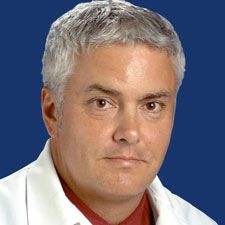Overview on Metastatic CRPC and Available Treatment Options
Expert oncologists Tanya Dorff, MD, and Elisabeth Heath, MD, FACP, reflect on the current treatment paradigm for patients with metastatic castration-resistant prostate cancer (mCRPC).
EP: 1.Overview on Metastatic CRPC and Available Treatment Options
EP: 2.Practical Considerations for Sequencing Cabazitaxel in Metastatic CRPC
EP: 3.The PROSELICA Trial: Cabazitaxel Dosing in Metastatic CRPC
EP: 4.Interpreting Data From the CARD Trial in Metastatic CRPC
EP: 5.Metastatic CRPC: Considering Use of Combination Cabazitaxel/Carboplatin
EP: 6.Optimizing Patient Selection for Cabazitaxel Therapy in Metastatic CRPC
EP: 7.Metastatic CRPC: Selecting Patients for Cabazitaxel or Radiotherapy
EP: 8.Addressing Barriers to Care in Metastatic Castration-Resistant Prostate Cancer
EP: 9.Metastatic CRPC Management: Future Directions in Care
Transcript:
Tanya Dorff, MD: Hi. I’m Dr Tanya Dorff. I’m chief of the genitourinary disease program head of the genitourinary cancers section at the City of Hope, in Duarte, California. And I’m pleased to be speaking with Dr Heath today.
Elisabeth Heath, MD, FACP: Hi, everyone. I’m so glad to be here tonight. My name is Dr Elisabeth Heath. I’m a professor of oncology at the Karmanos Cancer Institute in Detroit, Michigan. I lead the GU [genitourinary] program there, as well. And I serve as the associate center director for translational sciences. [I am] really excited about tonight’s program.
Tanya Dorff, MD: We’re talking about metastatic castrate-resistant prostate cancer [mCRPC], which is a big focus of my clinical work, as well as my research. I’m really interested to hear your insights, as well, on some of the new data. Obviously, we know that most men who develop metastatic disease and are treated do become castration resistant. That’s the most aggressive and lethal form of the disease, so that’s why we focus so much effort on the treatment. When we think about whether incidence is changing over time it may not be that the incidence is changing, but the patients [who] develop castration resistance might have had different treatments that they’ve been exposed to today than they would have in the past. What do you think about that?
Elisabeth Heath, MD, FACP: I agree. We’re certainly getting better at detecting metastatic disease, whether we want to or not. I think the imaging has forced this to move forward. Whether you’re seeing a lot of prostate patients or they’re a subsection of your practice because it’s such a common cancer, we’re almost forced to really understand what’s happening. So, it seems like there’s a lot of new information in this area, which is terrific for our patients.
Tanya Dorff, MD: When we think about who’s at greater risk for becoming castration resistant and when we’re starting them on their initial hormone therapy, I think about things like a really high volume of disease already [receiving a diagnosis of] metastatic disease vs relapsing after definitive treatment, high Gleason scores, of course. And I think we’re starting to learn about the genomic underpinnings, and how some patients face greater risk, depending on what their DNA changes are in their individual cancers. Are there any other factors you think about when you’re counseling a patient about what their risk is, or when they might develop castration resistance?
Elisabeth Heath, MD, FACP: I agree. I think where the landscape is changing is it’s not that our patients have gotten healthier. Now, in addition to all this new treatment in the castrate-sensitive space, which will impact what we do in the resistant space, you’re [considering] so many other things, like their comorbidities. Unfortunately, I do treat patients with diabetes, which is one of the most common, and hypertension. Then you roll that all in together, and try to maintain their quality of life, and make sure they know what’s happening. It’s become quite complex. That’s probably happening all over the country. And that’s what makes…treating [patients with] mCRPC even more complicated because the lead-in to it has changed and keeps changing.
Tanya Dorff, MD: You raised a great point about comorbidities. I’d love for you to go through some of the different drugs or types of agents that we have available to treat mCRPC. Especially thinking about which comorbidities maybe make it important for us to have these kinds of different options for patients, and not just 1 limited sequence of choices.
Elisabeth Heath, MD, FACP: Don’t you feel like, sometimes, after you discuss all the different drugs, with patients, they’ve just taken a Biology 101 lecture? They always kid about that, because they have that glaze-over look, like a lot of our students, and ourselves when we were getting taught this in school and training. But a lot of people are familiar with the taxanes. I think docetaxel and cabazitaxel have remained a staple in our tool kit. A lot of the novel hormonal therapies have become much more utilized these days. I still see a fair share of patients undergoing radium-223 treatment. I think many people now—unless you really haven’t kept up with the news—are all about the lutetium-177 PSMA [prostate-specific membrane agents]. I do think that sipuleucel-T is still in the mix, as well, for a certain subset of patients. We can’t forget about the PARP inhibitors, because of the patients [who] have HRD [homologous recombination deficiency] mutations. Then you’ve got to figure out if they’re flying solo, or whether you must combine them, and then the sequencing. The good part is you and I have choices now. The bad part is we have choices now. And then you’re trying to project ahead, what to do. And then, of course, in the mix of all this, we’re also doing some things to their bones, such as long-term androgen deprivation. Even with that, there’s a new oral agent, to also help maintain the castration levels. When you put it all together, you’re like, “What do you do first? What do you do second?” And constantly changing, again, based on the comorbidities and/or other things that are going on in the patients’ lives. Patient input and choices, in terms of what they want for themselves, really matters as well. So it’s good and bad. But you and I will look at it as mostly good because we want options to be able to treat our patients.
Tanya Dorff, MD: Especially throw in an extra wrench like COVID-19. And then being able to have options that suppress the immune system less or cause the patient to come into the cancer center less. It was nice to have not just 1 choice, and say, “You either do this or we don’t do anything,” right? But it does lead to some confusion. I know, with NCCN [the National Comprehensive Cancer Network] guidelines, we’re stuck with that kind of menu, for better or worse. So, there is a lot of informed patient decision-making.
Transcript edited for clarity.



